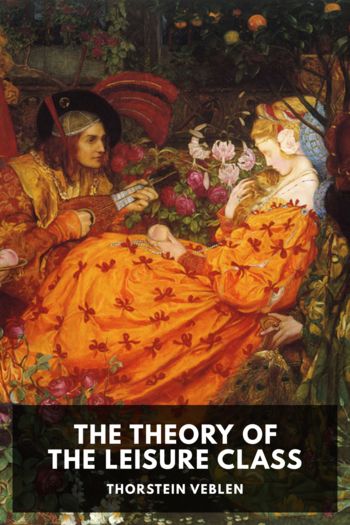The Theory of the Leisure Class by Thorstein Veblen (phonics readers TXT) 📕

- Author: Thorstein Veblen
Book online «The Theory of the Leisure Class by Thorstein Veblen (phonics readers TXT) 📕». Author Thorstein Veblen
Under the recognized laws of heredity there may be a survival from a more or less remote past phase. In the ordinary, average, or normal case, if the type has varied, the traits of the type are transmitted approximately as they have stood in the recent past—which may be called the hereditary present. For the purpose in hand this hereditary present is represented by the later predatory and the quasi-peaceable culture.
It is to the variant of human nature which is characteristic of this recent—hereditarily still existing—predatory or quasi-predatory culture that the modern civilized man tends to breed true in the common run of cases. This proposition requires some qualification so far as concerns the descendants of the servile or repressed classes of barbarian times, but the qualification necessary is probably not so great as might at first thought appear. Taking the population as a whole, this predatory, emulative variant does not seem to have attained a high degree of consistency or stability. That is to say, the human nature inherited by modern Occidental man is not nearly uniform in respect of the range or the relative strength of the various aptitudes and propensities which go to make it up. The man of the hereditary present is slightly archaic as judged for the purposes of the latest exigencies of associated life. And the type to which the modern man chiefly tends to revert under the law of variation is a somewhat more archaic human nature. On the other hand, to judge by the reversional traits which show themselves in individuals that vary from the prevailing predatory style of temperament, the ante-predatory variant seems to have a greater stability and greater symmetry in the distribution or relative force of its temperamental elements.
This divergence of inherited human nature, as between an earlier and a later variant of the ethnic type to which the individual tends to breed true, is traversed and obscured by a similar divergence between the two or three main ethnic types that go to make up the Occidental populations. The individuals in these communities are conceived to be, in virtually every instance, hybrids of the prevailing ethnic elements combined in the most varied proportions; with the result that they tend to take back to one or the other of the component ethnic types. These ethnic types differ in temperament in a way somewhat similar to the difference between the predatory and the ante-predatory variants of the types; the dolicho-blond type showing more of the characteristics of the predatory temperament—or at least more of the violent disposition—than the brachycephalic-brunette type, and especially more than the Mediterranean. When the growth of institutions or of the effective sentiment of a given community shows a divergence from the predatory human nature, therefore, it is impossible to say with certainty that such a divergence indicates a reversion to the ante-predatory variant. It may be due to an increasing dominance of the one or the other of the “lower” ethnic elements in the population. Still, although the evidence is not as conclusive as might be desired, there are indications that the variations in the effective temperament of modern communities is not altogether due to a selection between stable ethnic types. It seems to be to some appreciable extent a selection between the predatory and the peaceable variants of the several types. This conception of contemporary human evolution is not indispensable to the discussion. The general conclusions reached by the use of these concepts of selective adaptation would remain substantially true if the earlier, Darwinian and Spencerian, terms and concepts were substituted. Under the circumstances, some latitude may be admissible in the use of terms. The word “type” is used loosely, to denote variations of temperament which the ethnologists would perhaps recognize only as trivial variants of the type rather than as distinct ethnic types. Wherever a closer discrimination seems essential to the argument, the effort to make such a closer discrimination will be evident from the context.
The ethnic types of today, then, are variants of the primitive racial types. They have suffered some alteration, and have attained some degree of fixity in their altered form, under the discipline of the barbarian culture. The man of the hereditary present is the barbarian variant, servile or aristocratic, of the ethnic elements that constitute him. But this barbarian variant has not attained the highest degree of homogeneity or of stability. The barbarian culture—the predatory and quasi-peaceable cultural stages—though of great absolute duration, has been neither protracted enough nor invariable enough in character to give an extreme fixity of type. Variations from the barbarian human nature occur with some frequency, and these cases of variation are becoming more noticeable today, because the conditions of modern life no longer act consistently to repress departures from the barbarian normal. The predatory temperament does not lead itself to all the purposes of modern life, and more especially not to modern industry.
Departures from the human nature of the hereditary present are most frequently of the nature of reversions to an earlier variant of the type. This earlier variant is represented by the temperament which characterizes the primitive phase of peaceable savagery. The circumstances of life and the ends of effort that





Comments (0)